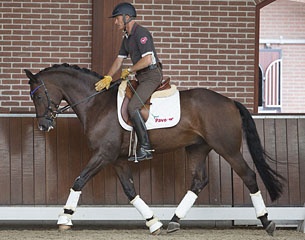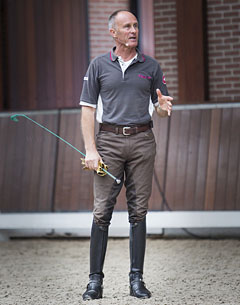
In all the years he has been teaching riders from all around the world, Rien van der Schaft noticed that the core of 99% of all of the problems riders deal with spiral down to one phase in the training. According to Rien, it’s the phase most riders forget about or don’t do correctly: getting the right connection.
Rien explains: “It’s the first phase we go through when we start riding our horses and an essential phase if you want to have the training fundamentals in place. Basically what you want to achieve in this phase is three things, namely relaxation, forwardness and that your horse accepts the contact. And to be more precise, not only that your horse accepts the contact, but that he finds the contact pleasant. I call this phase the contact rein.”
“Ride the horse forward to the bridle and do not care about the head-neck position until your horse accepts the bit and wants to stay in contact with the rider’s hand. A lot of riders think their horse is forward, but actually it isn’t. Most of the times it’s something you find out when you progress in the training and you run into problems. But even more so, the problem of the first phase has to do with the contact.”
“I believe you shouldn’t want to try to influence the head-neck position into a certain frame, before the horse accepts the bridle and goes with that contact in his natural frame and balance. Sooner than most riders think, when riding in a good way the horse will come into a right frame.”
“When a horse, instead, comes against the bit, he’s telling you he doesn’t like the contact and doesn’t trust your hand. He braces himself to prevent himself from getting hurt. If you prevent your horse from coming against the bit, it might look better, but you don’t take away the reason why your behaves that way. You don’t solve the problem.”
Don’t start by making a certain head-neck position
“I advice riders to just follow the mouth of the horse the best they can. Once your horse trusts your hand, he won’t come against the bit anymore. He will find the position that’s most comfortable for him. That’s never a position where your horse moves with head up or with his nose to his chest.”
And that makes sense. When you lunge your horse without any side reins, you will never see your horse moving with his head all the way up or too deep. He will most of the times move with his head in a forward-down direction.
So how long does this phase take?
“Usually, it only takes a couple of days before your horse learns to trust your hand. You can see big improvements in a short amount of time. However, I’ve also encountered horses where it took several weeks. I can assure you it didn’t look ‘professional’ when one is riding horses and follow their mouth while they kept their head up.”
 “When the rider’s hand follows the movement of the horse’s head and the contact stays consistent and soft, soon the horse will trust the hand and likes to stay in touch with the hand. But you have to give your horse the time he needs.”
“When the rider’s hand follows the movement of the horse’s head and the contact stays consistent and soft, soon the horse will trust the hand and likes to stay in touch with the hand. But you have to give your horse the time he needs.”
“And from there, you can start to capture the forwardness and redirect that into a more solid connection. But you can’t take that step if your horse doesn’t trust your hand. It will definitely lead to problems in the connection. One should only resist the impulsion from behind with the hand if the horse accepts the contact and from that moment on we can call it ‘connection.’”
“So if you’re having problems with the connection, go to the phase of the contact rein and make sure you have it established before taking the next step. And it doesn’t matter if you’re riding Novice Level or Grand Prix, allow your horse to go through that phase.”
If you’re unsure whether you have the right fundamentals in place, you can check out this test you can download for free. If you want to go more in depth, check out the online training Rien van der Schaft has created in collaboration with DressagePro in which he teaches the training of dressage horses in four steps.
About Rien van der Schaft
Rien van der Schaft runs a professional dressage yard "Stable Sprengenhorst" with his wife Inge and daughter Romy. As of 2017, Rien has been appointed team trainer of the Dutch National Dressage Team. Rien has trained and competed nine horses up to Grand Prix level and trained many more. He was member of the Dutch team from 1979 till 1983 and competed at the Alternate Olympic Games in Goodwood, two European Championships and one World Championship.
To learn more about the online training, visit http://dressagepro.com/online-program-from-basics-to-grand-prix/
Download the free "Training Fundamentals Online Test"
text by Conny Loonstra - Photos © Jennifer Fotografie